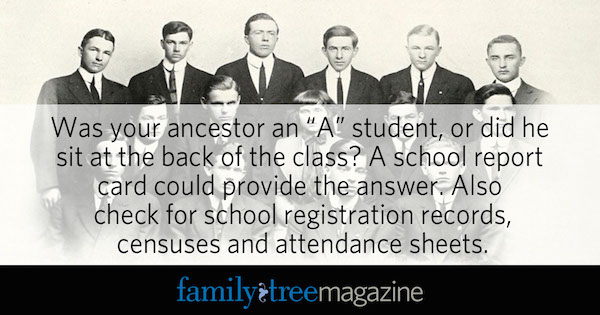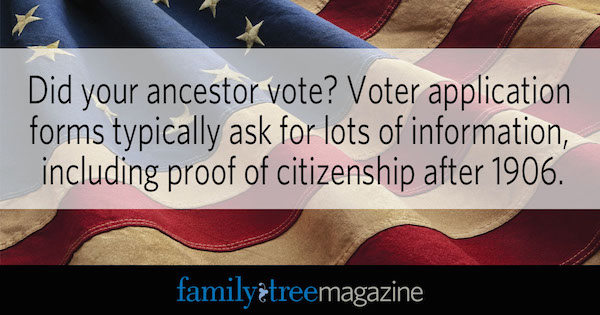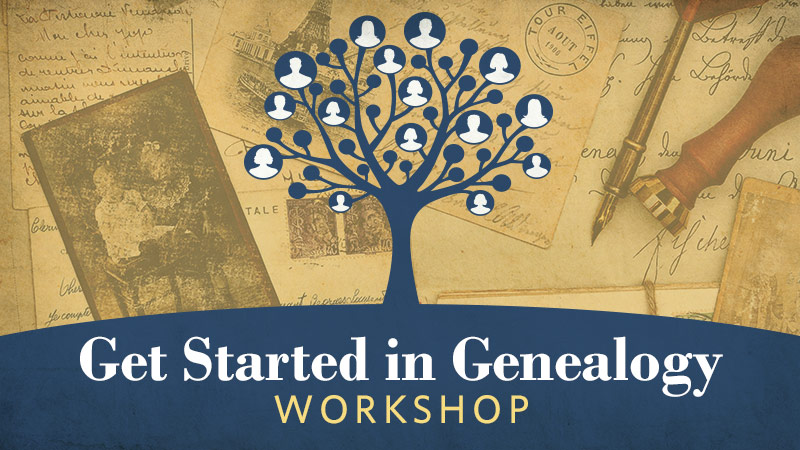Sign up for the Family Tree Newsletter Plus, you’ll receive our 10 Essential Genealogy Research Forms PDF as a special thank you!
Get Your Free Genealogy Forms
"*" indicates required fields
Who doesn’t have a box of old pictures in an attic or closet? If you’re lucky, they’ll have names and dates on the back. But many of us inherit mystery photographs without any labels at all. Get advice about identifying your images from Family Tree Magazine’s Photo Detective, Maureen A. Taylor, who solves photo mysteries at blog.familytreemagazine.com/
photodetectiveblog and in her just-released book Family Photo Detective. And try uploading your unidentified photos to sites where others might recognize them, such as DeadFred or Ancient Faces.
When I started doing genealogy more than 22 years ago, I didn’t have the luxury of online birth, death and other records. But my mother had saved my Slovak grandparents’ baptismal certificates, which gave me their birth dates, parents’ names, religion and villages—all crucial facts I used to obtain additional records. Ask your relatives whether they inherited any of these documents.
Documents associated with a relative’s job may describe his or her appearance, health, next of kin, and work history. I have my grandfather’s 1900s worker passbook (a document issued to tradesmen in Austria-Hungary). It’s in Hungarian and I had to pay to have it translated, but it details his work in Austria-Hungary (now Slovakia), his date and place of birth, his religion, and his physical appearance. I also have his apprenticeship certificate showing his occupation as a “Cartwright/assistant/helper.” This document helped prove a family story that my grandfather’s ability to fix wheels saved his life during World War I. You can read more about finding and using occupational records in the December 2011 Family Tree Magazine.
Grade school, high school and college books are great sources of ancestor photos. You also may learn whether your relative was into sports or voted homecoming queen or most likely to succeed. Subscription sites Ancestry.com and World Vital Records have digitized yearbooks. Also scour libraries where the school is located, and if it’s still open, contact school personnel about arranging a visit.
I learned about my father’s Naval service from his induction and discharge papers, dog tags and especially his Navy diary. In this small brown notebook, he jotted down details such as the day he entered service, Aug. 16, 1943, and the position of his ship in the Pacific when the Japanese surrendered in 1945. Military insignia, uniforms, awards, letters and other documents offer similar clues. Follow up by searching for service records and pension papers—start with the websites listed at familytreemagazine.com/article/best-websites-for-
genealogy-research-in-military-records-2012.
One of my favorite treasures is my father’s scrapbook of his days playing high school and semi-professional basketball. Keeping books of photographs, newspaper clippings and other memorabilia was once a popular pastime you can learn more about in The Scrapbook in American Life, edited by Susan Tucker, Katherine Ott and Patricia P. Buckler (Temple University Press). Not only are scrapbbooks a genealogical gold mine, but they also offer a deeper glimpse into an ancestor’s life and those who meant the most to him or her.
The availability of funeral home records varies by time and location, but if you can find these documents, you may learn how and where a person died, names of relatives, the place of burial, and who paid for the funeral. Some homes collected additional details, such as occupation, military service and the name of the deceased’s insurance company. If these aren’t in a relative’s home, contact the funeral home that handled your ancestor’s burial. If it’s no longer in business, see if another home acquired it and check with local genealogical and historical societies.
These goodies could give you the names of an ancestor’s relatives and friends invited to a wedding or baptism, as well as who sent cards and gifts.
Baptismal, First Communion, Confirmation, Bar or Bat Mitzvah and other religious records commemorate significant moments in an ancestor’s faith journey. They also could contain personal details you might not find in civil vital records—or substitute for missing vital records. To find these, search the Family History Library online catalog by place and look for a church records category.
14. International money orders
If you come across a naturalization certificate in Mom’s attic, on FHL microfilm or online (subscription sites Fold3.com and Ancestry.com have collections, as does the free FamilySearch.org), use it to track down the immigrant’s declaration of intent and petition for naturalization. Pre-1906 original records are with the court where the person filed for citizenship. The search gets easier starting in 1906, when the federal government took over the naturalization process; request these records from the US Citizenship and Immigration Service (USCIS) Genealogy Service.

Nothing beats a firsthand account of events in an individual’s own words. You might be imagining a leather-bound book labeled “Diary,” but your ancestor could have recorded his or her thoughts in a notepad. If a diary isn’t among your family papers, a search of the WorldCat online catalog might turn up a relative’s unpublished journal in a library or historical society. But remember that published diaries of your ancestors’ contemporaries could also provide insight into their lives. To find these, consult the bibliographies listed at familytreemagazine.com/article/finding-a-diary.
Old letters can reveal family news and an ancestor’s thoughts on current events. Don’t forget to check the envelopes for names and addresses of your ancestor’s relatives, and postmarks for hometowns (including foreign towns or villages). If you’re the lucky guardian of family correspondence, remove letters from their envelopes and unfold, but keep them together.
You can use an ancestor’s Social Security Number to request his or her application for an SSN (called the SS-5). If you can’t find a Social Security card, search the Social Security Death Index on FamilySearch.org; it lists deaths mostly from 1962 and later that were reported to the Social Security Administration. Be aware that current and pending legislation may influence what information you can obtain with your SS-5 request.
Think of postcards as the Facebook or Twitter of yesteryear—your ancestors would write quick notes of birthday or holiday greetings, show where they’d traveled or immigrated, or share sights from their hometowns. During the era of photo postcards (about 1899-1930s), people would have family photos developed on cardstock with postcard backs. Besides checking at home, look for historical postcards in Ancestry.com’s free US Historical Postcards collection. Also search websites such as eBay, VintagePostcards and Old Fulton Postcards.
These social organizations became popular in the late 1800s. Immigrants often established fraternal or benevolent organizations, such as the Order Sons of Italy in America, to provide insurance and preserve their traditions. Our ancestors also joined the Freemasons, Woodmen of the World, International Order of Oddfellows and more. You might be able to find an ancestor’s membership application, organization newsletters and other documents. Use Google to see if the organization still exists and contact its archives. Its records also may be in a library or on FHL microfilm.
Bank statements, checkbooks, deposit slips, receipts and other papers—often among the documents family members stashed away—can clue you in to a person’s economic status, business dealings and life events. Also check online databases for ancestors’ unclaimed funds (state auditors often maintain these) and keep an eye out for bankruptcy notices in old newspapers.
Old address books give you relatives’ names and (obviously) addresses, which can help you search for their census, deed and other records. These books also can be great sources of living folks who might remember something about your ancestors. Not everybody keeps address books around, but you also can look for addresses in old city directories and phone books. They’re often at libraries in print or on microfilm; subscription sites Ancestry.com and Fold3.com have digitized collections. Use the Online Historical Directories portal to find more sources.
Though not everyone had passports, if you find an ancestor’s among family papers, the applications can be an excellent source of genealogical information—especially about foreign-born folks. Check the National Archives and Records Administration’s (NARA) Guide to Passport Applications. You can search passport applications (1795-1925) at Ancestry.com or find them on FHL microfilm.
Many people recorded births, marriages and deaths in the family Bible, or perhaps kept a prayer book. These can reveal details about vital events and an ancestor’s religious affiliation, and perhaps names of churches to contact for baptism, funeral and other religious records.
Folks tended to save Christmas, birthday and anniversary cards as mementos from loved ones. The annual holiday newsletter might be packed with family news and milestones such as births, marriages and divorces. Birthday and anniversary cards from family members or friends can tell you who was in your ancestor’s inner circle—great for breaking down brick walls with cluster genealogy.
If your ancestor played high school, college or pro sports, you might find scorecards, playbooks, newspaper articles and other records of his participation. My father’s scrapbook has newspaper clippings and photos from his career as a high school basketball star and later, on community and semi-professional teams. Even if you don’t have such a treasure, look for school yearbooks and newspaper articles, and search the collections of local historical societies.
Sure, death records can tell you how an ancestor died, but medical papers, insurance cards and doctor’s notes can give you a picture of what happened before those final moments. This is important for compiling a family health history. Among my parents’ things was a scrap of paper on which my grandmother wrote (in Slovak) her doctor’s instructions after she was diagnosed with cancer. For clues on where to find medical records, see familytreemagazine.com/article/nine-steps-to-a-health-history.
A relative may have saved birth announcements, obituaries and news stories mentioning family, but newspapers also are readily available online and in libraries. Subscription sites GenealogyBank and Ancestry.com have large newspaper collections; you’ll find links to other online papers at the Online Historical Newspapers site. Search the newspaper directory at Chronicling America to find names of general, ethnic, labor, religious and other papers published when and where your ancestor lived. Search results tell you which libraries hold the papers you need.
If your ancestor was on the wrong side of the law, you can usually track him in court cases, prison records and newspaper accounts—see the November 2009 Family Tree Magazine for tips on tracing ne’er-do-well ancestors or download our $4 research guide from shopfamily tree.com/research-strategies-criminal-records. Such a fellow may even turn up in wanted posters; see genealogy.about.com/b/2012/09/04/wanted-family-history-in-wanted-posters.htm.
Records of how a relative acquired his or her property will provide personal details and the location of the land. The July/August 2012 Family Tree Magazine will help you find deed records (these are usually on FHL microfilm or in original form at county courthouses). Land obtained from the federal government should be recorded in land patents, searchable at www.glorecords.blm.gov, and land entry case files (held at NARA; see archives.gov/research/land for information).
These organizations often played central roles in our ancestors’ lives, so look for bulletins, histories and anniversary booklets. You’ll find background, names of prominent members, photos and other tidbits. I have a booklet commemorating the 25th anniversary of the Slovak Club in Duquesne, Pa., where my father and uncles were members. If the church or club still exists, check its archives; otherwise, scour the local museum or historical society. University libraries often have great collections of local historical ephemera, such as Central Connecticut State University’s Polish American Pamphlets.
Flip through that decade-old calendar in Mom’s desk drawer before you toss it. She might have jotted down birth, death or anniversary dates, or other milestones.
Jewelry, clothing, furniture, figurines, tools and other heirlooms could be hiding clues such as engravings of names and dates or emblems of organizations your relative belonged to. If you don’t find these in a relative’s home, search auction websites for old objects associated with your surnames and check the subscription heirloom exchange at JustAJoy. See the October/November 2012 Family Tree Magazine for more advice on hunting down family heirlooms.
One of my uncle’s old home movies shows my grandmother standing on her back porch. If you’re lucky to have family on film, you can get a look at relatives, hear their voices and see what they were like. No home movies? Learn about the life and times of your ancestors from films of their contemporaries. Check out the Library of Congress’ American Memory collection and NARA’s Digital Vaults.
Voices from the past lend color to the names, dates and places in your family’s history. Give a quick listen to old cassette and answering machine tapes before you throw them out. You can listen to others’ stories in collections such as the Veterans Oral History Project (search the site lcweb2.loc.gov/diglib/vhp/html/search/search.html to see if any interviewees served with your soldier) and Ancestry.com’s Ellis Island oral histories.
Not all inventors were as well known as Thomas Edison. Even average folks obtained patents for their innovations. Google’s free Patent Search lets you peruse patents and published patent applications from the US Patent and Trademark Office and the European Patent Office.
Not many folks managed to escape the tax man. You’ll find some local tax records on FHL microfilm (run a Place search on the county). Otherwise, check with the town, city or county for detailed records and statements for income, business, property and other miscellaneous taxes.

Did your ancestor vote? Voter application forms typically ask for lots of information, including proof of citizenship after 1906. You’ll get confirmation of your ancestor’s location between censuses and clues that can help you find naturalization papers. Voter records are typically found through the city or county level board of elections, though old records may have been sent to a local archive or destroyed.
You never know where an ancestor’s name may turn up. To find academic papers and manuscripts he may have written or been mentioned in, search the Periodical Source Index (available as part of Ancestry.com’s subscription, or free through libraries that offer HeritageQuest Online). If your ancestor is in this index, you can order a copy of the article he was in from the Allen County Public Library. Also check out Archive Grid, Repositories of Primary Sources and Google Scholar (for scholarly papers).
Playbills, festival flyers, concerts and sporting programs may contain an ancestor’s name, photo or biography. If they’re not among family papers, you might stumble across these items in local repositories and ephemera sales.
Known in the genealogical community as “cousin bait,” these online journals let you write about your family history and brick wall problems. The Geneabloggers directory lists more than 2,500 blogs covering everything from research in specific places to particular families. You also can use Google Blog Search to look for blogs relevant to families and places you research.
You may not think of social media websites such as Twitter, Facebook, GooglePlus and Pinterest as places where you can find family history treasures. These sites are excellent venues, though, for connecting with kin who may have family items, as well as for leaving virtual breadcrumbs of your own. Search the site of your choice for family names and genealogical societies in the places your family lived.
Before there was Facebook, there were genealogy forums such as those on Ancestry.com and FamilyTreeMagazine.com. Message boards are still excellent places to pick up tips, ask questions, and find people researching the same surnames or localities as you. Another advantage: Posts on social media sites tend to fade quickly from memory, while message board posts have more permanence.
If you look beyond the surprised kitty and dancing baby videos, you might find interesting history videos on sites such as YouTube or Vimeo. Search on a family name or town, adding genealogy or family history to narrow your results. Find how-to videos, too, on channels such as Family Tree Magazine and Genealogy Gems.
Genealogy website Fold3.com has millions of profile pages generated from names in the Social Security Death Index, or a relative might have set up pages for your ancestors. You can contribute photos, documents and stories to existing profile pages or create them from scratch by registering for a free account. (With a Fold3.com subscription, you can add premium content from the site.) I used memorabilia from my father’s US Navy service to create his page; you can see it at www.fold3.com/page/20077589_john_a_alzo_jr. See Creating a Memorial Page on Fold3 for further instruction.
You may find family information, old photographs or stories on a distant cousins family history website or on community-based sites such as USGenWeb county pages, Saving Memories Forever or History Pin.
Your greatest family history treasure might come from within—literally. Many genealogists use genetic genealogy testing as a way to prove (or disprove) family relationships when the paper trail of traditional research ends. Various tests let you explore DNA along Y-DNA (male), mtDNA (female) and autosomal lines. FamilyTree DNA, AncestryDNA and 23andMe are just a few companies that provide ancestry DNA tests. Even if you don’t get tested, you can search for your family names in DNA databases that pair test results with surnames, such as the one on the Sorenson Molecular Genealogy Foundation website.
- Flea markets, antique stores and tag sales: Albums, scrapbooks, medals, autograph books, church and local organizations’ brochures and more might show up in “junk” stores and yard sales. These finds are usually luck of the draw, but if you make friends with shop proprietors, they may call you about merchandise you might be interested in.
- Auction websites: You’ve probably searched eBay for lost family heirlooms. Also try Goodwill’s auction site, Just a Joy, Craigslist and Webidz.
- Book and ephemera sales: Visit these sales to look for old books, brochures and postcards. See Hal Lutsky’s Vintage Paper Fair and the sale listings at Antiquarian Book and Ephemera Fairs.
- Museums: These can be gold mines of pamphlets, newspapers, letters, photos and more ephemera from local families and organizations.
- Libraries and historical and genealogical societies: See if your library has surname files with news clippings and papers related to area families. It also may have collections of family papers, local histories and yearbooks.
Related products on shopfamilytree.com:
ADVERTISEMENT





